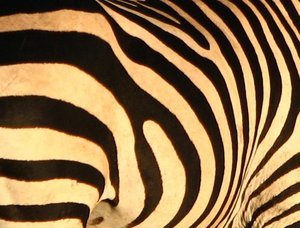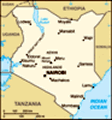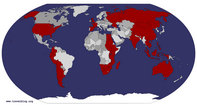Advertisement
Published: June 10th 2009

 Hide
Hide
Of a zebraI've been looking forward to my 4 day safari to the Masai Mara and Lake Nakuru National Parks with a mixture of excitement and trepidation - excitement at being on the verge of seeing one of the most famous game reserves on the planet, and trepidation at sharing that experience with some strangers. One big plus of independent travel is that you can choose just how much interaction you have with others, but this safari will force me to be sociable for its duration. I wonder if I'll crack under the strain.
I'm the first customer to be picked up and the vehicle is unlike the ones I'd seen on my previous safaris a decade ago in South Africa. It's a 4WD Toyota minibus with a raisable roof, allowing the occupants to stand upright and look outside unhindered by windows. The driver doubles as the guide and he turns out to be extremely good, though it must be tiring work given the enormous amount of driving involved, often in hardly ideal conditions.
There are just 5 of us in the group, meaning that it's comfortable inside the minibus. I will later see similar vehicles with 7 or 8 occupants

 Hide
Hide
Of a Masai giraffeand they look rather cramped. Our group is mixed, with an Italian woman and her Kenyan husband (who I learn later from the driver are on honeymoon though they don't tell anyone else this), plus a couple of Spanish pharmacists working for NGOs in Ethiopia. All pleasant people, though I cause immediate consternation at the lunch stop via the stereotype-confounding announcement that I'm English but drink neither tea nor coffee.
Most of day one will be spent in transit to the Masai Mara NP, and soon people have donned MP3 players to pass the time. The road out of Nairobi is in good condition but it gradually deteriorates as we get closer to the park, though our average speed doesn't seem to drop much. Intercity transport seems to be mainly catered for by
matatus, minivans driven with scant regard for the speed limit and covered with slogans and adverts depicting everything from the Arsenal line-up c.2003 to Nicole Scherzinger. Quotes from the Bible and references to the power of God seem to be attempts to divert responsibility from the driver to a higher being. Accidents are apparently extremely frequent and I have read that the best approach when choosing
a vehicle is to pick one with an old driver, as his age will be indicative of his road sense. I notice that all number plates here begin with a K, which seems like a waste of a space.
We have a brief stop at a viewpoint over the Great Rift Valley, that enormous break in the Earth's surface stretching from northeastern Ethiopia down to Mozambique. There are several shops nearby, and we each receive what I'm coming to recognise as the standard Kenyan begging conversation - first an attempt to sell me something, then a request for me to give
them something, then finally an outright plea for money.
As we get closer to the park, we start to see members of the Masai tribe in the surrounding countryside. Many wear red check wraps, with beaded items around their necks and arms. Spears are a common sight. There are also plenty of grazing animals, supposedly belled so as to prevent attack by their wild brethren. I'm surprised that we still see herds of cows even when we're within the park's boundaries, as I'd thought this was illegal. A few zebras also appear, grazing idly, but it's only

 Hide
Hide
Of a cheetahwhen a large group of Thomson's gazelles speeds across the road in front of us that I finally realise we're nearly there.
Our accommodation is at a permanent camp not far from the Oloolaimutia Gate. It's close to a rather grim little village filled with corrugated iron buildings, butcheries, "hotels" (apparently the word is often used here to mean a restaurant), and a petrol station warning "No smooking". I'm pleasantly surprised by my room - essentially a permanent tent with a banda to keep the rain off. It even comes with its own toilet and shower, the latter a futuristic affair with its head concealed in the ceiling.
We dump our stuff, have a short welcome introduction, then head out on a late afternoon game drive. I don my shorts for the first time on this trip, finding a laundry-mangled subte ticket from Buenos Aires in a pocket, which I wonder might be a sign.
One large component of any safari cost in Kenya is the fees for the parks - Masai Mara costs $40 per DAY, Lake Nakuru $60. Interestingly, the Kenya Wildlife Service is in charge of most of the parks (including Lake Nakuru) and
has much stricter rules to go along with its higher fees (e.g. you can only drive on the existing tracks and not go off-road). The Masai Mara NP, however, is owned by a Masai organisation and allows you to go anywhere you like.
I had assumed that this first game drive would be merely a makeweight, to give us customers the feeling that day 1 of our safari wasn't all just driving to the park, but it is actually amazing. My only other African safari experiences were in South Africa, near Port Elizabeth, about 10 years ago and the passing years haven't treated the memories kindly. This is a totally different feeling. Just metres into the park, we pass a herd of zebras. From then, our spotting list grows to contain impala, wildebeest, crowned cranes, topi (a kind of antelope), lion (a pride resting, and later another pride at the kill site of a buffalo), dik dik, Thompson's gazelle (tails constantly flapping to keep flies out of where the sun don't shine), giraffe, elephant, buffalo and hartebeest, and no doubt others that slip my mind or are lost in the plethora of beasts. Many have young with them too.
I am again left to rue the sensor in my camera - with the light quite dim, and animals having the annoying tendency of never actually staying still, I end up with a haul of blurry and grainy shots. Of course the entire experience is to the background noise of Mediterranean chatter.
It seems as though we are lucky - it's normally low season now because of the rains, but with the rains being late we have the benefits of good viewing/driving conditions but few other tourists. The driver tells us that, in high season, there are so many minibuses at places of interest that the park can resemble more a series of
matatu terminals.
We return to the camp shortly after sunset, all enthused by what we have seen and eagerly awaiting the next installment the following day. There is a large group of Kenyan tourists also in residence, who we had seen in the park in their bright blue school bus.
The camp seems to be staffed entirely by men, even in the kitchen (which has posters of - who else? - Barack Obama on the door). There are several Masai among them though, given
their reputation, they are disappointingly short. One measure of Masai male handsomeness is having a large hole in your ear lobe, and I see a few ears where the hole is so big that the owner could loop the lobe up and wrap it around the top of their ear - which seems to defeat the purpose of having the hole in the first place.
I chat with one of the Spaniards about his work in Ethiopia - he is 3 months into a 1 year contract. He says that he has encountered an entitlement mentality in the country, with many people thinking that foreign assistance is simply due to surpluses in the West rather than any actual desire to help. His work involves the treatment of patients with HIV, malaria, and malnourishment, with HIV being the biggest problem. His NGO is based in the northeastern deserts of Afar and, after the safari, he is looking forward to several days of beach life near Mombasa.
The power is turned off at 10PM, though most of the residents are already in bed by then. I notice a few mossies humming around my tent, but they fail to find the
holes in my mosquito net and I have an uninterrupted sleep.
Breakfast is a sausage and beans extravaganza which makes me swoon, and we then pile into the minibus for what will be an entire day in the Masai Mara. It's hardly worth trying to describe the thrill of seeing so many different creatures, so I'll simply list the new ones - mongoose, secretary bird, ostrich, warthog, and an owl. We startle a cheetah padding along by the side of the track at about the same time as several other minibuses converge on it - it seems troubled at being surrounded, but eventually breaks out and lopes off to a safe distance from our prying lenses. We visit several times the kill site from the previous day where a pride of lions had taken down a buffalo. After the lions have had their fill and retired, bloated, under some bushes for a nap, the scavenging jackals and vultures come in for the scraps.
We then move to the savannah proper, flat and only sparsely treed. We find a mother cheetah and her pair of cubs, as well as about 8 other minibuses that are jostling for the best
photographic position, a glimpse of what everywhere in the park must look like in high season. Next, we pass some hyenas lying in mud to keep cool before arriving at the border between the Masai Mara and Serengeti. I don't know how this has been defined, but it's marked by a dull concrete pillar that seems incredibly popular as a backdrop for people's photos.
At about midday we arrive at a spot on the Mara River with a large population of hippos and crocodiles. An armed guard accompanies us on our walk along the river bank, and shows great care in ensuring there are no crocs (in particular) lying in wait for tourist flesh. This part of the river is where the wildebeest come through on their famous annual migration between the Serengeti and Masai Mara, so it's a prime hunting place at that time for crocs and big cats. I'm too early for the migration here but may catch the start of it in Tanzania once I've looped through Uganda and Rwanda. We only see a couple of crocs but there are numerous hippos of all sizes from babes up to monsters.
We have a picnic lunch
at our furthest point into the park, in the presence of blue-balled monkeys and astoundingly colourful blue/red karma lizards. The journey back to the camp sees us add elands, the largest of the antelopes, to our list of seens. I will read later that, though the park might appear to be bursting with wildlife, there has been a more than two thirds decline in numbers over the last 15 years of giraffes, warthogs, impala, and hartebeest. On the plus side, a leopard is currently terrorising the dog population of one of Nairobi's suburbs.
There has been a huge personnel shift in the camp during the day, and we spend the evening amongst groups of young Americans, Israelis, and Canadians.
Our final morning in the Masai Mara is spent on another game drive, during which we see a lioness carrying a young cub in her mouth. We also encounter a minibus which has become stuck in a water channel. I am amused that it belongs to one of the higher end holiday companies. Its companion minibus is trying to drag it out but appears more likely to tip it over rather than help it. Other minibuses appear and everyone
shamelessly takes photos - the family inside the marooned vehicle no doubt view this with gritted teeth. Our driver shows his skill by taking over operations - with some nifty pedalwork and accompanied by the sound and smell of a roaring engine, we slowly pull the stricken minibus to safety.
We breakfast back at the camp then pack our gear and leave the Masai Mara, driving first cross-country and then on paved road until we hit our lunch spot. The Spaniards are not continuing to Lake Nakuru, and it also turns out that our driver has caught malaria so needs to head back to Nairobi, so the remaining three of us are lumped in with a Danish guy and his existing driver. The Danish guy is here mainly to attend his cousin's wedding to a Kenyan, and he has been staying in one of the slum areas of Nairobi, which he says has been an experience involving tear gas.
The rest of the afternoon is spent driving to Lake Nakuru, in weather that progresses from grey and cloudy to rain. We pass a school with the delightful name of the Whizzkids Academy. Nakuru was the site of much
violence in the wake of the elections at the beginning of 2008 but there are no obvious signs of that bloody period in its recent history.
In Nakuru town, I am surprised to find that we are staying in a hotel rather than a camp, though this is no bad thing given the appearance of the weather. I distinguish myself by not being able to get out of my room and have to pass the key through the bathroom window so someone can let me out from the outside. This is only hours after I try to break open a container of toothpicks in order to get at the contents, until someone gently points out that there is a hole in the top, so I think senility is already setting in.
The driver is worried when only the Danish guy and I show up for dinner, as he says that Nakuru is dangerous at night so he is afraid of something happening to the honeymooners. A brown-out prevents close inspection of the buffet dinner, though it certainly tastes fine. The honeymooners show up several beers later, the husband depressed - they have been watching the Arsenal-Chelsea game at

 Ear
Ear
Of an elephanta nearby pub and the score has not gone in Arsenal's favour. We say our goodnights and arrange for an early breakfast the next day.
Dull but possibly useful info i. I booked my 4 day/3 night Masai Mara/Lake Nakuru safari through Jocky Tours (sic) for $420. Jocky are affiliated with the Terminal Hotel. However the vehicle for the Masai Mara portion was owned by Big Time Safaris (who also owned the camp) and the vehicle for the Lake Nakuru portion was owned by Come To Africa safaris. I can only assume that these smaller agencies work together but it does mean it's hard to know just which agency you will end up with.
ii. All meals were included, including the lunch breaks when driving, so cash was only needed for drinks and (where appropriate) tips.
iii. Electricity in the camp is only available from 5-6:30AM and 7-10PM, though there seemed to be hot water all day.
iv. Service in the camp was generally fine though the broken plug socket that I was promised would be fixed was never even looked at.
v. Both the drivers were excellent, so if you get Joseph or Dan then you shouldn't have
any worries on that score.
Advertisement
Tot: 0.441s; Tpl: 0.017s; cc: 38; qc: 160; dbt: 0.2951s; 1; m:domysql w:travelblog (10.17.0.13); sld: 1;
; mem: 1.6mb




















































liliram
liliram
Zoomed-in shots?
I didn't see any blurry shot......in fact, your photos are absolutely good! Like those 'rear' photos. Nice one, john. But I just had to ask how far away you were when you took those lion shots.